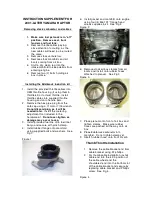
7) When refrigerant container (3) is emptied, use following proce-
dure to replace it with a new refrigerant container (3).
a. Close low pressure valve.
b. Replace empty container (3) with a refrigerant container
which has been charged with refrigerant. When using refrig-
erant container tap valve (4), use following procedure for re-
placement.
i) Retract needle (1) and remove refrigerant container tap
valve (4) by loosening its plate nut (2).
ii) Install previously-removed refrigerant container tap
valve (4) to a new refrigerant container (3).
c. Purge any air existing in center charging hose
When using refrigerant container tap valve, use following
procedure to purge air.
i) Once fully tighten refrigerant container tap valve and then
loosen (open) plate nut slightly.
ii) Open low pressure valve of manifold gauge set a little.
iii) As soon as refrigerant comes out with a “hiss” through a
clearance between refrigerant container and tap valve,
tighten plate nut as well as manifold gauge set low pres-
sure valve.
iv) Turn handle of tap valve clockwise so that its needle is
screwed into the new container to make a hole for refrig-
erant flow.
1. “Hiss”
8) After the system has been charged with specified amount (500
– 600 g) of refrigerant or when low pressure gauge (1) and high
pressure gauge (2) have indicated about 2 and 15 kg/cm
2
re-
spectively, close low pressure side valve (3) of manifold gauge
set (4). At this time, look into the sight glass (6) of receiver/dryer
(5) and check that there are no bubbles (7) in it, which means
that the system is fully charged.
Low pressure gauge when charged with specified amount
About 150 – 200 kPa (1.5 – 2.0 kg/cm
2
)
High pressure gauge when charged with specified amount
About 1300 – 1700 kPa (13 – 17 kg/cm
2
)
1B-20
AIR CONDITIONING (OPTIONAL)
SH410
Содержание Zen
Страница 2: ......
Страница 233: ...6E1 6 ENGINE AND EMISSION CONTROL SYSTEM SH410 ...
Страница 358: ... SH410 Prepared by Overseas Service Department 1st Ed January 2000 Printing January 2000 356 ...
















































